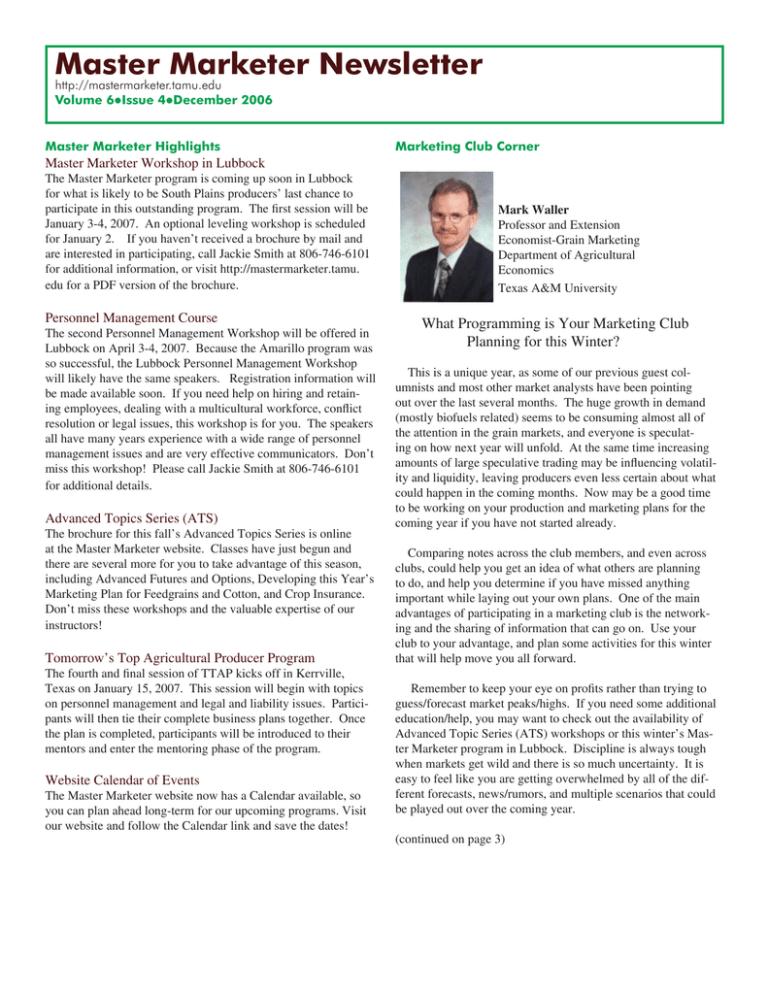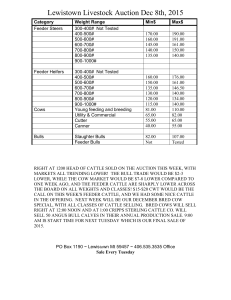Master Marketer Newsletter Master Marketer Workshop in Lubbock
advertisement

Master Marketer Newsletter http://mastermarketer.tamu.edu Volume 6zIssue 4zDecember 2006 Master Marketer Highlights Marketing Club Corner Master Marketer Workshop in Lubbock The Master Marketer program is coming up soon in Lubbock for what is likely to be South Plains producers’ last chance to participate in this outstanding program. The first session will be January 3-4, 2007. An optional leveling workshop is scheduled for January 2. If you haven’t received a brochure by mail and are interested in participating, call Jackie Smith at 806-746-6101 for additional information, or visit http://mastermarketer.tamu. edu for a PDF version of the brochure. Personnel Management Course The second Personnel Management Workshop will be offered in Lubbock on April 3-4, 2007. Because the Amarillo program was so successful, the Lubbock Personnel Management Workshop will likely have the same speakers. Registration information will be made available soon. If you need help on hiring and retaining employees, dealing with a multicultural workforce, conflict resolution or legal issues, this workshop is for you. The speakers all have many years experience with a wide range of personnel management issues and are very effective communicators. Don’t miss this workshop! Please call Jackie Smith at 806-746-6101 for additional details. Advanced Topics Series (ATS) The brochure for this fall’s Advanced Topics Series is online at the Master Marketer website. Classes have just begun and there are several more for you to take advantage of this season, including Advanced Futures and Options, Developing this Year’s Marketing Plan for Feedgrains and Cotton, and Crop Insurance. Don’t miss these workshops and the valuable expertise of our instructors! Tomorrow’s Top Agricultural Producer Program The fourth and final session of TTAP kicks off in Kerrville, Texas on January 15, 2007. This session will begin with topics on personnel management and legal and liability issues. Participants will then tie their complete business plans together. Once the plan is completed, participants will be introduced to their mentors and enter the mentoring phase of the program. Website Calendar of Events The Master Marketer website now has a Calendar available, so you can plan ahead long-term for our upcoming programs. Visit our website and follow the Calendar link and save the dates! Mark Waller Professor and Extension Economist-Grain Marketing Department of Agricultural Economics Texas A&M University What Programming is Your Marketing Club Planning for this Winter? This is a unique year, as some of our previous guest columnists and most other market analysts have been pointing out over the last several months. The huge growth in demand (mostly biofuels related) seems to be consuming almost all of the attention in the grain markets, and everyone is speculating on how next year will unfold. At the same time increasing amounts of large speculative trading may be influencing volatility and liquidity, leaving producers even less certain about what could happen in the coming months. Now may be a good time to be working on your production and marketing plans for the coming year if you have not started already. Comparing notes across the club members, and even across clubs, could help you get an idea of what others are planning to do, and help you determine if you have missed anything important while laying out your own plans. One of the main advantages of participating in a marketing club is the networking and the sharing of information that can go on. Use your club to your advantage, and plan some activities for this winter that will help move you all forward. Remember to keep your eye on profits rather than trying to guess/forecast market peaks/highs. If you need some additional education/help, you may want to check out the availability of Advanced Topic Series (ATS) workshops or this winter’s Master Marketer program in Lubbock. Discipline is always tough when markets get wild and there is so much uncertainty. It is easy to feel like you are getting overwhelmed by all of the different forecasts, news/rumors, and multiple scenarios that could be played out over the coming year. (continued on page 3) Guest Column David Anderson Professor and Extension Economist-Cattle Marketing Department of Agricultural Economics Texas A&M University The big story in the cattle market late this year is feed costs. It looks like that is going to continue to be the dominant story over the next few months, although herd expansion will likely be an interesting topic early in the year. In terms of the cattle cycle and expansion, drought in the Southern Plains seriously reduced cow numbers and producer’s ability to continue the expansion that had already begun. Lower calf prices due to higher feed costs will also be a moderating factor in this cycle. The near doubling of cash corn prices over the last 2 months beat down feeder cattle and calves sharply. Using the old rule of thumb that a $0.10 per bushel increase in corn prices reduces feeder cattle by about $0.60 per cwt and 5-600 pound calves by $1.00 per cwt the price declines in the feeder cattle market were even stronger than might have been expected. Feeder cattle prices dropped about $20 per cwt and so did 5-600 pound calves, off of almost a $2.00 increase in cash corn prices per bushel. While the cattle price decline has had a serious negative impact on stocker cattle returns for those animals that were already purchased, it has led to some other important changes. One is a sharp decline in projected fed cattle breakevens, particularly out into March and April. Projected breakevens have declined close to $10 per cwt from January, 2007 to April, 2007. The lower breakevens reflect a much tighter price spread between feeder steers and fed steers. That spread has been, historically, very high over the last couple of years, making it difficult to pencil positive feeding returns, even with fed cattle over $90 per cwt. The rest of the story on feeder cattle is that the increase in feed costs roughly coincided with the decline in the fed cattle market. Fed cattle prices have declined about $5 per cwt over the last 2 months further pushing feeder prices lower in combination with feed prices. Given that high feed prices will likely remain for a long period of time, we should expect them to continue to pressure cattle prices. A very slow cattle inventory On the positive side for feeder cattle and calves is that expansion will continue to support cattle and calf prices, we continue to have relatively tight supplies. It’s likely although not at the level of the past couple of years. Calf that relatively tight supplies will remain for some time prices will remain at a level that indicates some expangiven a drastic slowdown in herd expansion. sion, but that expansion will be heavily dependent on rain and pasture conditions throughout the Southern and Great The January 1, 2007 cattle inventory report should Plains. It appears that there will be some opportunity indicate a beef cow inventory very close to a year ago. pencil positive returns feeding cattle even with high feed Not only has cow slaughter been high this year in response prices. to drought, but heifer slaughter has picked up sharply in the last 6 weeks. The increase in heifer slaughter reflects the large numbers of heifers placed on feed throughout the course of the year and drought forced heifer sales. However, the total cattle inventory should be higher given the large numbers of cattle on feed. Choice Website Elizabeth Spillmann Extension Associate-Risk Management Texas A&M University AgWeb www.AgWeb.com This month’s choice website is www.AgWeb.com. AgWeb is put out by Farm Journal and is a great source for national market news, current events updated daily, farming tips, and expert commentary. AgWeb also contains separate sections for equipment and individual crops for agricultural producers to find information in specific subject areas, and a classifieds section for equipment. The main menu has sections for weather, money, markets, and even a nationwide discussion forum for visitors from all areas and production systems to ask questions and discuss current events in agriculture, or anything from money to politics. AgWeb is an easy-to-use site with up to date information on the national agricultural scene and another great source for online information. Marketing Club Corner, continued from page 1: During the 1995/96 bull market and subsequent price decline, numerous producers told me that they had marketing plans in place and knew what they should have done, but that it was difficult to stick to their plan in the face of so much volatility and uncertainty. We were actually asked by 1996 Master Marketer graduates to include a marketing psychology type instructor for the 1996 Master Marketer graduates update, and the 1997 Master Marketer program as a result of the discipline concerns. Some advisory services and marketing programs provided by grain merchandisers could also be useful if you need a little help sticking to executing, or readjusting your marketing plan as the year unfolds. FARM Assistance Update Melissa Jupe Extension Program Specialist Department of Agricultural Economics Texas A&M University In order to address the needs of both individual producers and the agriculture industry as a whole, the FARM Assistance team has published several reports this fall. The Texas Agriculture 2006: The Road to Success illustrates the activities and results of approximately 200 of the most recent program participants while the 2006 FARM Assistance Texas Livestock Producers Report includes approximately 75 livestock producers. Both reports utilize FARM Assistance data to dissect and summarize producers of different levels of success, types, commodities, and practices in order to help all Texas producers improve their management information and financial success. The 2006 Focus Series collection is expanded by two new studies spotlighting the Impact of Volumetric Water Pricing for Cotton and Sugarcane Comparing Furrow versus Surge Irrigation in the Lower Rio Grande Valley. These studies are the result of a water demonstration project conducted in cooperation with the Harlingen Water District and the Texas Water Development Board. Both studies attempt to compare and analyze how a model 38-acre farm would be impacted if water pricing structure in this area was changed. All of the reports can be read in full at the FARM Assistance website: farmassistance.tamu.edu/publications. In this Issue Master Marketer Highlights 1 Marketing Club Corner 1 Guest Column 2 Choice Website 3 Farm Assistance Update 3 Prepared by: Mark Waller Professor and Extension Economist-Grain Marketing and Policy Department of Agricultural Economics Texas Cooperative Extension Texas A&M University College Station, Texas 77843-2124 If you would like to receive this newsletter by email, or have any other questions about the Master Marketer system, please write Elizabeth Spillmann at ershaw@ag.tamu.edu. Educational Programs of Texas Cooperative Extension are open to all citizens without regard to race, color, sex, disability, religion, age or national origin. Issued in furtherance of Cooperative Extension Work in Agriculture and Home Economics, Acts of Congress of May 8, 1914, as amended, and June 30, 1914, in cooperation with the United States Department of Agriculture, Texas Cooperative Extension. The Texas A&M University System. Partial funding support for the Master Marketer program has been provided by the Texas Wheat Producers Board, Texas Corn Producers Board, Texas Farm Bureau, Houston Livestock Show and Rodeo, and Cotton Inc.-Texas State Support Committee.







